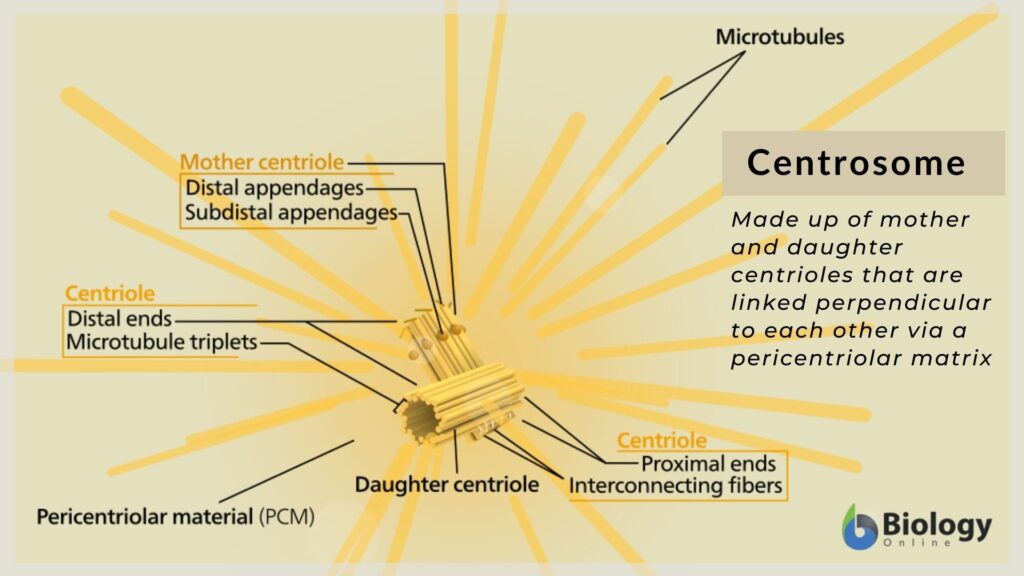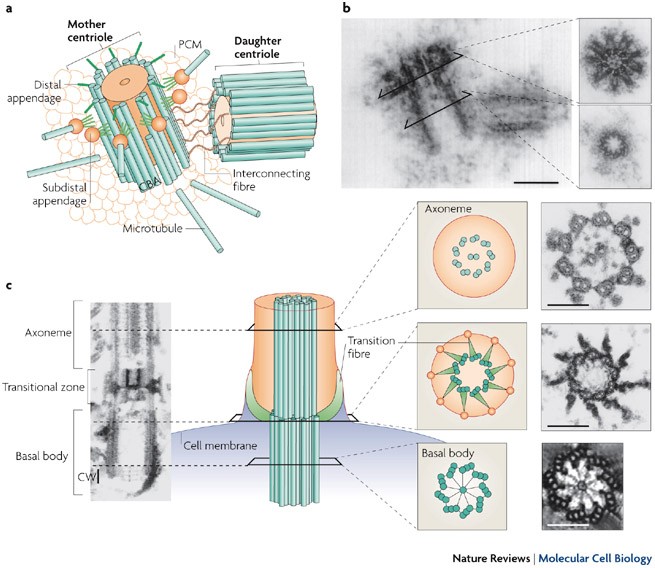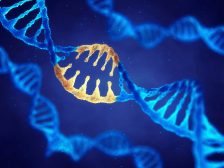
Centrosome
n., plural: centrosomes
[sɛntrəˌsəʊm]
A cytoplasmic structure located near the nucleus; made up of two orthogonally-arranged centrioles surrounded by an amorphos mass of pericentriolar material
Photo: electron micrograph of centrosome in a dividing cell (see black arrow).
Table of Contents
Centrosome Definition
What is a centrosome? The centrosome is considered to be the main microtubule-organizing center (MTOC) therefore regulating cell adhesion, motility, and polarity. It also promotes the spindle pole organization in an animal cell during mitotic replication. Defects in the function of spindle-organization are present in many cancers and may be attributed to genomic instability. Irrregular or extra centrosomes may contribute to abnormal cell division.
What does a centriole do? A centriole is the main component of the centrosome; it has an important function as basal bodies that contribute to the development and formation of flagella and cilia, which have important developmental, physiological, and disease functions. Therefore, the strict regulation of the number of centrosomes and centrioles is essential to maintain a healthy organism.
Biology definition:
A centrosome is an organelle located near the nucleus in the cytoplasm that divides and migrates to opposite poles of the cell during mitosis and is involved in the formation of the mitotic spindle, assembly of microtubules, and regulation of cell cycle progression. Etymology: from Latin “centrum” and Greek “kentron”, meaning “center” + Greek “soma”, meaning “body”.
By the end of the nineteenth century, Theodor Boveri realized the importance of the centrosome, raising many of the key questions that intrigue us now about the control of the centrosomal number and the function of the centrosome in the development of many types of cancers.
For more than 30 years, the centrosome has been known to replicate during the S phase of the cell cycle. However, although DNA licensing is well understood, the mechanism of centrosome replication or regulation is not fully understood. Additionally, centrioles in animal cells may reform de novo if they were naturally or artificially eliminated or damaged.
What is the centrosome in a cell? A centrosome with two centrioles is an organelle involved in several processes in the cell including embryogenesis, sensation, and locomotion.
In the past, centrosomes were believed to be inherited through centrosome replication from an existing centrosome since the centrosome is passed during fertilization to the zygote, moreover, it is an important organelle for spermatogenesis. However, recent studies have shown that centrosomes are mostly derived de novo without using an existing centrosome as a template; additionally, during fertilization, the centrosome usually degrades before fertilization in the oocyte so the offspring do not rely on the parents’ centrosome during embryogenesis.
Are centriole and centrosome the same? No, centriole is a part of the centrosome. Centrosome typically contains two centrioles arranged perpendicularly to each other; centrioles are made up of microtubules that are essential for cellular division.
Therefore, during cell division, the two centrioles move to both sides of the nucleus to initiate mitotic division. Centrioles release mitotic spindles that pull the chromosome from both sides to start mitotic replication.
Where is the centrosome? The centrosome is the area where centrioles normally are present. When the cell is not undergoing mitotic division, the two centrioles indicate the position of the nucleus upon examination since the centrioles are normally present next to the nucleus.
Centrosomes are one of the fundamental microtubule nucleating centers. They have the ability to organize the arrays of microtubules in animal cells by controlling their anchoring and their release. The animal cell centrosome is more flexible and more complex than that of fungal cells even though molecular mechanisms are commonly involved in fungal and animal cells.
Centrosome behavior differs according to the cellular phase of the cell cycle, and whether it is a quiescent cell or a growing cell. Moreover, centrosome behavior differs in G1 phase from S phase.
Do plant cells have centrosomes? Microtubules organization is essential for proper cell division. Centrosomes are the main organelles responsible for the organization of microtubules within the dividing cell. However, most plant cells do not contain centrosomes. Alternatively, plant cells contain other microtubule-organizing centers that act as an alternative for centrosomes.
Recent studies have shown that microtubules can organize themselves into arrays if some types of motor proteins are present. The centrosome found in the cells of multicellular organisms originates from the basal body found in the unicellular organisms. The centrosome organizes the cell’s cytoskeleton as well as various cellular functions such as mobility, adhesion, polarity, and intracellular trafficking.
During proliferation, the centrosomes replicate at the S phase of the cell cycle so that the two centrosomes can contribute to the cellular division using the mitotic spindles. Additionally, the centrosome mediates the arrangement and assembly of the mitotic spindle during mitosis, which is necessary for proper chromosome segregation, even though the centrosome is not necessary for this process, however, centriole replication is organized with the cell cycle.
Centrosome Structure
What are centrosomes? In animal cells, researchers usually define the centrosome as the main microtubule-organizing center that is responsible for the organization and nucleation of microtubules. Microtubules assist in the support by their cytoskeleton; moreover, they influence the cell polarity by tethering their ends to the centrosome.
The main centrosome is usually present close to the nucleus to allow other specific locations in the cell to be occupied by other microtubule-associated organelles. The centrosome consists of two centrioles which are surrounded and interconnected by fibers and the pericentriolar material.
Each centriole consists of nine triplets of microtubules forming a barrel-shaped structure. The two centrioles are perpendicular to each other. They are structurally different from each other. The mother centriole is characterized by distal and subdistal appendages that serve as basal bodies by anchoring the centrioles to the cell membrane.
When cells divide, microtubules arise from the centrosome to guide vesicle and organelle traffic during mitotic and meiotic cell division. The pair of centrioles are connected together by a large protein through the proximal region.
Because the centrioles are developed from the basal bodies they are structurally similar to them. The centrosome can be detected using a light microscope in eukaryotic cells, it is surrounded by a protein membrane called the pericentriolar material.
The centrosome plays a major role in several functions such as the organization of cell microtubules, therefore, the anchoring, release, and nucleation of the centrosome microtubules require the participation of several proteins.
The two centrioles in the centrosome, the mother centriole and the daughter centriole, are functionally and structurally different. However, both centrioles have microtubules that contribute to the process of cell division. The mother centriole is characterized by the presence of nine appendages arranged in two sets at its distal part. These appendages are essential, for instance, in the microtubules anchoring as well as the mother centriole docking during ciliogenesis at the plasma membrane in an inset cell.
The daughter centriole length is about 80% of the length of the mother centriole. The daughter centriole cannot dock the centrioles at the plasma membrane during ciliogenesis since it lacks the nine distal appendages. Additionally, the centrosome is only centered by the mother centriole.
The features of the centriole determine its properties, such as reproduction, polarity, stability, and dynamicity of the centrosome. Centrioles are highly stable; therefore, their microtubules are resistant to detergents and cold. This stability is provided by the components of the centrioles such as ribbon proteins and tektins so the centrioles survive over several generations of the cell.

Centrosome Functions
The main functions of centrosomes are discussed below. Their functions include serving as MTOC, flagella and cilia organization, and the regulation of the cell cycle.
Centrosomes as MTOC
Centrosomes have various functions in the cell, however, the main function of the centrosome is how it acts as MTOC. The centrosome arranges microtubule arrays according to its ability to anchor, release, or nucleate microtubules. The pericentriolar material as well as some protein kinases are involved in the nucleation of microtubules during the centrosome mitosis.
During mitosis, the pericentriolar material that nucleates and anchors the cytoplasmic microtubules. When the cell is preparing for division, the perinuclear material is thickened in a mechanism called centrosome maturation. Microtubule anchoring depends on different molecules, while other microtubule-serving proteins play a role in microtubule remodeling as well as the differentiation of certain types of cells, such as epithelial cells.
The variations in the centrosome’s microtubule nucleating potential during the cell cycle appear to be motivated by a balance between factors that can either facilitate or restrict the recruitment during mitosis and the interphase of microtubule-organizing molecules. Protein phosphorylation is important for this process where kinases, as well as Aurora-A, promote the nucleation of microtubules.
Aurora-A can also promote the development of microtubules from the centrosome by means of centrosome protein phosphorylation.
Flagella and cilia organization
Flagella and cilia originate from microtubules. They are projections that allow the cell to move, or promote the moving of substances that surround the cell. During different developmental and cellular processes, flagella and cilia have a great role in embryonic development, sensation, signals propagation, and motility.
Early stages of cilia development are not clearly understood, such as the formation of the basal body from the centriole. In contrast, centrioles, as well as centrosomes, can also be formed from cilia and flagella in vertebrate ciliated cells.
Cell cycle regulation of cell cycle
Centrosomes act as a platform of signaling because it includes regulatory complexes such as checkpoint proteins and tumor suppressors. As has been suggested to control the G1-S transition and cytokinesis, the centrosome may regulate the cell cycle.
Centrosome Evolution
The evolution of centrosomes in eukaryotes reflects the variation in eukaryotic cells among different organisms in terms of sensory reception, locomotion, or division with respect to the natural evolutionary process and adaptation of the organism.
The centrosome has been known to be a “polar corpuscle” of the cell. It is presumed to have a role in cell polarity maintenance as well as symmetrical cell breaking. The centrosome was studied as the organelle that coordinated cytokinesis and karyokinesis.
In order to avoid parthenogenetic development, the centrosome was absent from the unfertilized egg. The isolation of the centrosome from the fly and human in the last decade has revealed many proteins in eukaryotes.
A small amount of conserved proteins has been identified by functional genomics. These proteins have a role in the initiation of basal bodies and centrosome assembly and for the reproduction of the centrosome. The biochemical composition of the centrosome reflects its complexity of structure. Either the centrosomal matrix or the centrioles contain more than 100 proteins and these proteins may contain disease gene products, e.g. genes that contribute to the microcephaly syndrome.
In addition to restoring diploidy, the basal body/centrosome is responsible for the determination of the polarity of the embryo during fertilization where the fertilization of the egg in animals includes the transfer of the basal body associated with the head of sperm towards the centrosome associated either the male pronucleus.
Two cycles of cell division are required for the reproduction of the centrosome. This leads to the presence of a general asymmetry allowing for the presence of a daughter and a mother centriole in the centrosome. The cell polarity is controlled by the centrosome during its growth of tissues, migration, and homeostasis.

Biological Importance
The centrosome is a biologically important organelle. It controls the polarity of the cell as well as the nuclear positioning. Therefore, it influences the asymmetric distribution of organelles in the cell.
The centrosome organizes microtubules in eukaryotes, it could be replicated or synthesized de novo, therefore, centrosomes can be resynthesized after their destruction.
The centrosome is responsible for the nucleation of microtubules. It has a fundamental role in numerous processes of the cell such as the maintenance of cell polarity, position, distribution of organelles in the cell, chemotaxis, cell migration, and directional vesicle transport, in addition to the assembly of spindles during meiotic and mitotic division in several types of cells.
The centrosome controls the polarity and the position of microtubules within the cell. Consequently, it has an indirect influence on cell organelles that can interact with microtubules such as filaments of the cytoskeleton. Therefore, the centrosome is known to be the “dynamic center of the cell”.
The morphology, number, and distribution of centrosomes vary within the same cell. Moreover, their function in nucleating microtubules can also vary. Even though a typical eukaryotic cell contains one chromosome, the number of centrosomes duplicate during the mitotic division of the cell.
The two formed centrosomes direct the bipolar spindle assembly for the correct chromosomal segregation. Additionally, for the proper progression of the cell cycle, the proteins associated with the centrosome mediates the interaction between an enzyme and its substrate to coordinate cellular functions and the centrosome control.
Controversy Over Necessary
Even though the centrosome is believed to be an essential organelle for the division process of an animal cell, however, recent studies demonstrated that centrosomes are not essential for the transition of the G1-S phase. This finding was based on a study where the human cell progressed over the G1 phase even though the centrosome was removed by laser or microsurgery. However, the centrosome is essential for the transition of the G1-S phase where a study demonstrated that the loss of centrosome led to G1 arrest when the centriole was ablated followed by strong light exposure that produced great stress to the centrioles in the G1 phase.
Despite the existence of centrosomes at the poles of the spindle in most cells, they are not usually present during the meiotic division of the female oocyte. Moreover, no centrosomes are present in the cells of higher plants. In some species, the centriole contributes to the orientation of spindles as well as the assurance of mitotic fidelity. Additionally, centrioles are important for the formation of flagella and cilia.
Centrosome and Diseases
The centrosome is greatly involved in cell cycle regulation; therefore, it is expected to have a role in tumorigenesis. In almost all human tumor forms, including liver, breast, bone marrow, colon, prostate, and cervical cancer abnormalities were found in the number, structure, and size of the centrosome.
Centrosome amplification occurs because of depletion of tumor-suppressor protein (Rb) in mammals, as well as the BRCA1 breast cancer gene deficiency, centrosome amplification may also occur because of the aurora A overexpression in addition to other kinases that are involved in the progression of cancer.
The amplification of the centrosome could occur due to defects in cytokinesis or from dysregulation in the replication mechanism, which might lead to instability in the cell’s chromosome.
The centrosomal amplification in cancer leads to defects in cilia signaling, altered functioning of microtubules, lagging chromosomes, and asymmetric cell division which leads to overproliferation.
Try to answer the quiz below to check what you have learned so far about centrosomes.
References
- Bornens, M. (2002). Centrosome composition and microtubule anchoring mechanisms. Current opinion in cell biology, 14(1), 25-34.
- Bornens, M. (2012). The centrosome in cells and organisms. Science, 335(6067), 422-426.
- Palazzo, R. E., Vogel, J. M., Schnackenberg, B. J., Hull, D. R., & Wu, X. (1999). Centrosome maturation. Current topics in developmental biology, 49, 449-470.
- Azimzadeh, J., & Bornens, M. (2007). Structure and duplication of the centrosome. Journal of cell science, 120(13), 2139-2142.
- Meraldi, P., & Nigg, E. A. (2002). The centrosome cycle. FEBS letters, 521(1-3), 9-13.
- Doxsey, S., Zimmerman, W., & Mikule, K. (2005). Centrosome control of the cell cycle. Trends in cell biology, 15(6), 303-311.
- Keating, T. J., Peloquin, J. G., Rodionov, V. I., Momcilovic, D., & Borisy, G. G. (1997). Microtubule release from the centrosome. Proceedings of the National Academy of Sciences, 94(10), 5078-5083.
- Bettencourt-Dias, M., & Glover, D. M. (2007). Centrosome biogenesis and function: centrosomics brings new understanding. Nature reviews Molecular cell biology, 8(6), 451-463.
- Badano, J. L., Teslovich, T. M., & Katsanis, N. (2005). The centrosome in human genetic disease. Nature Reviews Genetics, 6(3), 194-205.
- Marc, J. (1997). Microtubule-organizing centres in plants. Trends in plant science, 2(6), 223-230.
©BiologyOnline. Content provided and moderated by BiologyOnline Editors.



